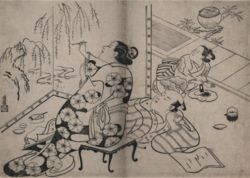
Torii Kiyonobu I
Encyclopedia

was a Japanese painter and printmaker in the ukiyo-e
Ukiyo-e
' is a genre of Japanese woodblock prints and paintings produced between the 17th and the 20th centuries, featuring motifs of landscapes, tales from history, the theatre, and pleasure quarters...
style, who is renowned for his work on Kabuki
Kabuki
is classical Japanese dance-drama. Kabuki theatre is known for the stylization of its drama and for the elaborate make-up worn by some of its performers.The individual kanji characters, from left to right, mean sing , dance , and skill...
signboards and related materials. Along with his father Torii Kiyomoto
Torii Kiyomoto
was a kabuki actor from Osaka and painter of billboards and other kabuki advertisements; the founder of the Torii school of artists, he painted in what would come to be known as an early form of the ukiyo-e style. Onstage, he went by the name Torii Shōshichi....
, he is said to have been one of the founders of the Torii school
Torii school
This article is about a school of ukiyo-e art; for the sculpture style, see Tori style. For the Torii samurai clan, see Torii family.The Torii school was a school of ukiyo-e painting and printing founded in Edo...
of painting.
Known in childhood as Shōbei, young Kiyonobu was the second son of the established Osaka
Osaka
is a city in the Kansai region of Japan's main island of Honshu, a designated city under the Local Autonomy Law, the capital city of Osaka Prefecture and also the biggest part of Keihanshin area, which is represented by three major cities of Japan, Kyoto, Osaka and Kobe...
kabuki actor and painter Torii Kiyomoto. He moved, with his father, to Edo
Edo
, also romanized as Yedo or Yeddo, is the former name of the Japanese capital Tokyo, and was the seat of power for the Tokugawa shogunate which ruled Japan from 1603 to 1868...
(modern-day Tokyo) when he was twenty-four, and emerged there as a major artist with a unique style. Kiyonobu's work is regarded as being highly influenced by that of Hishikawa Moronobu
Hishikawa Moronobu
was a Japanese painter and printmaker known for his advancement of the ukiyo-e woodcut style starting in the 1670s.-Early life and training:Moronobu was the son of a well-respected dyer and a gold and silver-thread embroiderer in the village of Hodamura, Awa Province, near Edo Bay. After moving to...
(d. 1694), the father of ukiyo-e; Kiyonobu would also have been well-versed, as most major artists were at the time, in the styles of the Kanō
Kano school
The ' is one of the most famous schools of Japanese painting. The Kanō school of painting was the dominant style of painting until the Meiji period.It was founded by Kanō Masanobu , a contemporary of Sesshū and student of Shūbun...
and Tosa school
Tosa school
The Tosa school of Japanese painting was founded in the 15th century, and was devoted to yamato-e, which are paintings specializing in subject matter and techniques derived from ancient Japanese art, as opposed to schools influenced by Chinese art....
s.
Kiyonobu focused almost exclusively on producing billboards and other promotional material for Edo's kabuki theaters; the relationship between the theaters and the Torii school was a strong and important one, and one that continues today. Guided by the need to attract attention, Kiyonobu's style tended towards bold, colorful exuberance. In addition to a distinctive use of color, details, and various other aesthetic elements, the Torii style is especially distinguished by the use of thick, bold line.
By 1700, Kiyonobu was a fully established and accomplished artist. His works were praised by contemporary writers, and were often even placed in Shintō
Shinto
or Shintoism, also kami-no-michi, is the indigenous spirituality of Japan and the Japanese people. It is a set of practices, to be carried out diligently, to establish a connection between present day Japan and its ancient past. Shinto practices were first recorded and codified in the written...
shrines as votive offerings, a fact which indicates something of the artistic quality or emotional impact of his depictions of Kabuki actors. By the time of his death in 1729, Kiyonobu had not only painted a great number of signboards and the like, but had also produced illustrations for woodblock printed books, depicting kabuki dramas, and had issued individual prints as well.
As is the case with most Torii school artists, Kiyonobu's dates are not known for sure, and the relationships between the various Torii artists are similarly unclear. The styles of Kiyonobu's disciples and relatives are very similar, and most scholars entertain the possibility that Kiyonobu II or Kiyomasu I
Torii Kiyomasu
was a Japanese painter and printmaker of the Torii school, in the genre of ukiyo-e. Like the other Torii artists, his primary focus was on Kabuki billboards, advertisements, actor prints, and other related material...
were the same man as the subject of this article, Kiyonobu I, or as one another. Very few, if any, paintings created by the Torii school are known definitely to have been painted by any one particular artist.
See also
- Torii Kiyonobu II - Kiyonobu's successor to be head of the Torii school, and likely his son
- Torii KiyomasuTorii Kiyomasuwas a Japanese painter and printmaker of the Torii school, in the genre of ukiyo-e. Like the other Torii artists, his primary focus was on Kabuki billboards, advertisements, actor prints, and other related material...
- a contemporary of Kiyonobu, in a somewhat different style. Kiyomasu may have been Kiyonobu's brother, or they may have even been the same man.

